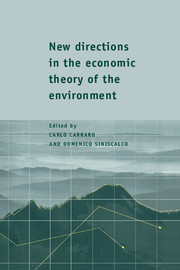Book contents
- Frontmatter
- Contents
- List of contributors
- 1 Theoretical frontiers of environmental economics
- 2 Growth with natural and environmental resources
- 3 Environmental policy and technological innovation
- 4 Environmental policy, distortionary labour taxation and employment: pollution taxes and the double dividend
- 5 International coordination of environmental taxes
- 6 Environmental policy and international trade
- 7 Environmental regulation and international capital allocation
- 8 Towards a theory of international environmental cooperation
- 9 Group formation in games without spillovers
- 10 Non-cooperative models of coalition formation in games with spillovers
- Index
4 - Environmental policy, distortionary labour taxation and employment: pollution taxes and the double dividend
Published online by Cambridge University Press: 11 January 2010
- Frontmatter
- Contents
- List of contributors
- 1 Theoretical frontiers of environmental economics
- 2 Growth with natural and environmental resources
- 3 Environmental policy and technological innovation
- 4 Environmental policy, distortionary labour taxation and employment: pollution taxes and the double dividend
- 5 International coordination of environmental taxes
- 6 Environmental policy and international trade
- 7 Environmental regulation and international capital allocation
- 8 Towards a theory of international environmental cooperation
- 9 Group formation in games without spillovers
- 10 Non-cooperative models of coalition formation in games with spillovers
- Index
Summary
Introduction
Environmental policy is traditionally analysed assuming that pollution externalities are the only market failures. In recent years, however, policy makers have increasingly recognised the importance of interactions between environmental policy and other policies aimed at addressing non-environmental distortions. In particular, the revenues from pollution taxes can be used to cut other, distortionary taxes. In conducting such an environmental tax reform, governments may reap a ‘double dividend’ – not only a cleaner environment but also non-environmental benefits associated with lower distortionary taxes (see e.g., Pearce (1991), Pezzey (1992), and Repetto et al. (1992)). Governments in Europe are particularly concerned about the adverse impact of high levels of distortionary labour taxation on employment and labour supply. Some analysts claim that a shift from labour towards environmental taxation may help to boost employment by encouraging employers to substitute labour for polluting inputs (including energy). Moreover, lower levels of labour taxation might stimulate labour supply.
The non-environmental dividend can be defined in various ways. This chapter focuses on the non-environmental dividend in terms of higher levels of employment. However, in addition to employment, other economic variables, such as transfers and profits, may directly impact overall welfare. Therefore, at several places, the chapter refers to changes in these non-environmental variables also as dividends.
The rest of this chapter is organised as follows. Section 2 develops a simple general equilibrium model to explore the employment and welfare effects of an environmental tax reform, i.e., raising environmental taxes and using the revenues to cut labour taxes. Due to the presence of a distortionary labour tax, a decline in employment produces a first-order loss in welfare (section 3).
- Type
- Chapter
- Information
- New Directions in the Economic Theory of the Environment , pp. 69 - 104Publisher: Cambridge University PressPrint publication year: 1997
- 6
- Cited by



